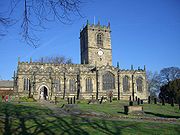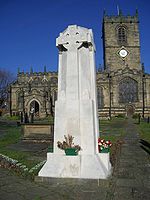
Church of St. Mary, Ecclesfield
Encyclopedia


Sheffield
Sheffield is a city and metropolitan borough of South Yorkshire, England. Its name derives from the River Sheaf, which runs through the city. Historically a part of the West Riding of Yorkshire, and with some of its southern suburbs annexed from Derbyshire, the city has grown from its largely...
, South Yorkshire
South Yorkshire
South Yorkshire is a metropolitan county in the Yorkshire and the Humber region of England. It has a population of 1.29 million. It consists of four metropolitan boroughs: Barnsley, Doncaster, Rotherham, and City of Sheffield...
, England
England
England is a country that is part of the United Kingdom. It shares land borders with Scotland to the north and Wales to the west; the Irish Sea is to the north west, the Celtic Sea to the south west, with the North Sea to the east and the English Channel to the south separating it from continental...
. It is situated seven kilometres north of the city centre. It is a Grade One listed building, one of only five within the Sheffield city boundary. It was originally the parish church for Hallamshire
Hallamshire
Hallamshire is the historical name for an area of South Yorkshire, England, in the current city of Sheffield.The origin of the name is uncertain. The English Place-Name Society describe "Hallam" originating from a formation meaning "on the rocks"...
, one of the largest parishes in England and in the 17th century was known as the “Minster of the Moors” due to its then rural situation.
History
The exact date for the creation of a church on the site of St. Mary’s is unknown. The name Ecclefield, which may mean “Church in the Field” in the Old English languageOld English language
Old English or Anglo-Saxon is an early form of the English language that was spoken and written by the Anglo-Saxons and their descendants in parts of what are now England and southeastern Scotland between at least the mid-5th century and the mid-12th century...
, is mentioned in the Domesday Book
Domesday Book
Domesday Book , now held at The National Archives, Kew, Richmond upon Thames in South West London, is the record of the great survey of much of England and parts of Wales completed in 1086...
(though the church is not), so it is possible that there might have been some sort of place of worship there before the Norman conquest of England
Norman conquest of England
The Norman conquest of England began on 28 September 1066 with the invasion of England by William, Duke of Normandy. William became known as William the Conqueror after his victory at the Battle of Hastings on 14 October 1066, defeating King Harold II of England...
. It has been implied by historians that the Anglo-Saxons
Anglo-Saxons
Anglo-Saxon is a term used by historians to designate the Germanic tribes who invaded and settled the south and east of Great Britain beginning in the early 5th century AD, and the period from their creation of the English nation to the Norman conquest. The Anglo-Saxon Era denotes the period of...
founded a church on the site between 625 and 650.
After the conquest and the repercussions of the Harrying of the North
Harrying of the North
The Harrying of the North was a series of campaigns waged by William the Conqueror in the winter of 1069–1070 to subjugate Northern England, and is part of the Norman conquest of England...
the lands around Ecclesfield passed to William de Lovetot
William de Lovetot
William de Lovetot, Lord of Hallamshire, possibly descended from the Norman Baron Ricardus Surdus, was an Anglo-Norman Baron from Huntingdonshire, often credited as the founder of Sheffield, England....
at the start of the 12th century. It was de Lovetot who built the first substantial church on the site, with a date of 1111 often given, however there is no written evidence to support this date. The church was given to the monks of Fontenelle Abbey
Fontenelle Abbey
Fontenelle Abbey or the Abbey of St. Wandrille is a Benedictine monastery in the commune of Saint-Wandrille-Rançon near Caudebec-en-Caux in Seine-Maritime, Normandy, France.-First foundation:...
, near Rouen
Rouen
Rouen , in northern France on the River Seine, is the capital of the Haute-Normandie region and the historic capital city of Normandy. Once one of the largest and most prosperous cities of medieval Europe , it was the seat of the Exchequer of Normandy in the Middle Ages...
, Normandy
Normandy
Normandy is a geographical region corresponding to the former Duchy of Normandy. It is in France.The continental territory covers 30,627 km² and forms the preponderant part of Normandy and roughly 5% of the territory of France. It is divided for administrative purposes into two régions:...
becoming an “alien priory”, a small group of monks came from France to live there. In 1386 Richard II
Richard II of England
Richard II was King of England, a member of the House of Plantagenet and the last of its main-line kings. He ruled from 1377 until he was deposed in 1399. Richard was a son of Edward, the Black Prince, and was born during the reign of his grandfather, Edward III...
dissolved the alien priories and handed over the church to the Carthusian
Carthusian
The Carthusian Order, also called the Order of St. Bruno, is a Roman Catholic religious order of enclosed monastics. The order was founded by Saint Bruno of Cologne in 1084 and includes both monks and nuns...
Monks of Coventry who held it until the Dissolution of the Monasteries
Dissolution of the Monasteries
The Dissolution of the Monasteries, sometimes referred to as the Suppression of the Monasteries, was the set of administrative and legal processes between 1536 and 1541 by which Henry VIII disbanded monasteries, priories, convents and friaries in England, Wales and Ireland; appropriated their...
in the late 1530s, when it was handed over to the Lords of Hallamshire
Hallamshire
Hallamshire is the historical name for an area of South Yorkshire, England, in the current city of Sheffield.The origin of the name is uncertain. The English Place-Name Society describe "Hallam" originating from a formation meaning "on the rocks"...
.
Construction of the present day church began in 1478 and was completed around 1500, being built in the perpendicular style
English Gothic architecture
English Gothic is the name of the architectural style that flourished in England from about 1180 until about 1520.-Introduction:As with the Gothic architecture of other parts of Europe, English Gothic is defined by its pointed arches, vaulted roofs, buttresses, large windows, and spires...
. Under Puritan
Puritan
The Puritans were a significant grouping of English Protestants in the 16th and 17th centuries. Puritanism in this sense was founded by some Marian exiles from the clergy shortly after the accession of Elizabeth I of England in 1558, as an activist movement within the Church of England...
s influence in the 1640s many of the church’s decorative pieces and all the stained glass was smashed after a 1643 Act of Parliament that stated "all representations of any angel or saint in any…parish church…was to be taken away, defaced and utterly demolished." Some of the surviving glass from the windows was pieced together and put into windows in the north aisle and vestry. The 18th and 19th centuries saw much re-ordering in the church especially to the nave and chancel under the respective vicars William Ryder and Alfred Gatty
Alfred Gatty
Alfred Gatty was a Church of England vicar and author.He was born in London to Robert Gatty, a solicitor, and Margaret Jones. In 1831 he entered Exeter College, Oxford, graduating in 1836. He was ordained a deacon in 1837 and was appointed as curate of Bellerby in the North Riding of Yorkshire...
.
In 1878, a football club representing Ecclesfield Church joined the Sheffield Football Association.
Present day
The 42nd Vicar of Ecclesfield is Revd. Daniel Hartley who was installed as vicar by the Bishop of Sheffield, Rt. Revd. Dr. Steven Croft, on 23 January 2011. A Yorkshireman, Daniel has spent the past 7 years based in Barnard Castle where he was chaplain to the HM Young Offenders Institution at Deerbolt. The church is built of local stone and has an octagonal font. The pulpit dates from 1876 with four panels carved with scenes from St. Pauls life, the lectern was installed at the same time. Since WWII, both the chancelChancel
In church architecture, the chancel is the space around the altar in the sanctuary at the liturgical east end of a traditional Christian church building...
and the nave
Nave
In Romanesque and Gothic Christian abbey, cathedral basilica and church architecture, the nave is the central approach to the high altar, the main body of the church. "Nave" was probably suggested by the keel shape of its vaulting...
have been given new roofs. The tower contains a peal of eight bells, two of which date from the 17th century. Music in the church is provided by a pipe organ. The church yard contains a war memorial made from light coloured stone, it was designed by R.B. Brookgreaves and has the names of 54 local people engraved on it who have given their lives in conflicts.
A carved cross shaft lies inside the church. It is around five feet high and lies in a double base. In the churchyard is a sundial
Sundial
A sundial is a device that measures time by the position of the Sun. In common designs such as the horizontal sundial, the sun casts a shadow from its style onto a surface marked with lines indicating the hours of the day. The style is the time-telling edge of the gnomon, often a thin rod or a...
mounted on a base with what may be an ancient lower part.

